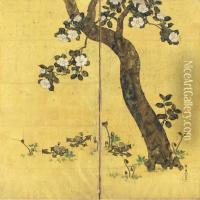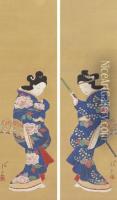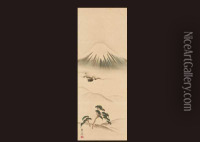Suzuki Motonaga Kiitsu Paintings
Suzuki Kiitsu, born Suzuki Motonaga in 1796, was a prominent Japanese painter known for his significant contributions to the Rinpa school of Japanese painting. His work is characterized by its vivid use of color and innovative composition, marking a revival and reinterpretation of the classical Rinpa style for the Edo period's late phase.
Kiitsu was born in Edo (present-day Tokyo) and initially started his career in a completely different field before dedicating himself to the arts. His transformative journey into the realm of painting began under the tutelage of Sakai Hōitsu, a master painter who himself had revitalized the Rinpa tradition. Under Hōitsu's guidance, Kiitsu not only honed his skills but also embraced the Rinpa aesthetic, focusing on nature, classical literature, and the seasons as primary subjects for his artworks.
Throughout his career, Kiitsu developed a distinctive style that set his works apart from his contemporaries. He is particularly noted for his masterful use of the tarashikomi technique, where ink or color is applied to a surface still wet from a previous application, resulting in a dripping effect that adds depth and intensity to the imagery. This technique, combined with his bold use of color and intricate detailing, allowed Kiitsu to create landscapes and floral compositions that were both vibrant and imbued with a sense of tranquility.
Kiitsu's legacy is significant in the context of Japanese art history. He played a crucial role in the Rinpa school's survival into the 19th century, ensuring its techniques and aesthetics were not lost to time. Today, his works are celebrated for their beauty and craftsmanship and are held in high esteem in collections both in Japan and internationally.
Suzuki Kiitsu's death in 1858 marked the end of an era for the Rinpa school, but his influence persisted. He left behind a body of work that continues to inspire artists and art lovers alike, serving as a testament to his mastery and the enduring appeal of the Rinpa aesthetic. His contributions to Japanese art have been recognized in numerous exhibitions and scholarly works, highlighting his role not only as a preserver of traditional techniques but also as an innovator within his field.










